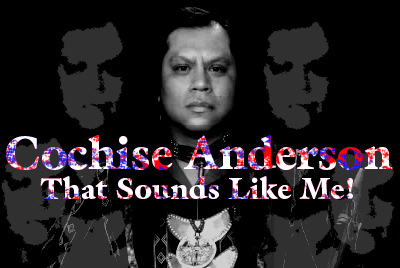|
|
||
Cochise Anderson Actor, playwright, spoken word performance artist, traditional musician, blues musician, and Native American cultural arts educator who most recently was on a national tour of the world premiere of William S. Yellowrobe Jr.’s play, The Grandchildren of the Buffalo Soldiers, presented by the Penumbra Theatre in St. Paul, Minnesota and Trinity Rep. in Providence Rhode Island.
That Sounds Like Me! It was a long time ago when a young, Native artist started out by graduating from acting school on the Upper West Side. He had a dream of becoming an actor. Getting roles based on his ability and not his appearance. Yep, that sounds like me! I remember going to meet an agent for the very first time, I remember him telling me how he was going to promote me as an “actor of color,” and I remember how my heart fell. His statement automatically cut half of any auditions I thought I might get; and disheartening as it was at the time, my New York journey was to take me to a place I still consider one of my homes. It was the fall of 1988 when one of my friends told me about the American Indian Community House which was on 14th Street by Union Square. After seeing a performance by the SpiderWoman Theatre, I milled around to tell anybody that would listen that I too was an actor. When they did listen, they were receptive and warm, and eventually they became my friends and mentors. I kept coming back and eventually landed a job as receptionist for the AICH where I became a part of what I thought was a burgeoning community. I was told by other artists to keep up my enthusiasm but keep in mind that challenges were still ahead, especially in the realm of having native voices heard by the rest of the world. The Spiderwoman, The Colorado Sisters, and the Thunderbird American Indian Dance Theatre all took me in while showing me different perspectives on the performing arts. I went to many auditions during that time including Dances With Wolves and Sun of Morning Stars but unfortunately, there was no cigar. Even though Native actors were beginning to be seen for Native roles, many auditions still bordered on humiliation. I remember going to a Bazooka Bubble Gum “go-see,” and having to take my ponytail out, cross my arms, and in my most Tonto-esque voice say “Bazooka!” However, I did get to meet Oliver Stone for a callback on The Doors even though there was still no cigar after the meeting. Despite the challenges though, I still had the opportunity to use my skills to be a storyteller at the annual Thunderbird American Indian Dance Theatre Winter Concerts; and I still remember my good friends Matoaka Little Eagle and Louis Mofsie trying to convince me I could and should do it. I truly appreciated their patience and belief in my talent. At the same time, however, I was playing blues harmonica and singing in a couple of blues bands around the city, and my friend Matoaka eventually introduced me to Soni Moreno, Pura Fe, Frank Menusan, Ken Littlehawk, Andy Wounded Knee, and Jeffrey Carpentier, and we soon came together to form the group Pura Fe, now known as Ulali. We traveled across the country performing and even into Canada to perform at the World of Music, Art, and Dance in Toronto. It was a fabulous time where I learned so much from so many talented people. I know now that my career as a flute player would not be what it is today without the support and patience of these generous artists. However, the many fruitless and sometimes humiliating auditions had me thinking that no one is writing well thought out, three-dimensional characters who happen to be Native American. I began to discuss the reasons why Natives couldn’t create their own theatre pieces with their own storylines with people like Vickie Ramirez, Elisa Cato, Irene Bedard, Kim Bassett, and Steve Elm. We eventually formed Chuka Lokoli Native American Theatre Ensemble (Chuka Lokoli meaning “community” in Chickasaw and Choctaw), collaborated with Curt Dempster at the Ensemble Studio Theater, and received a Nathan Cummings grant to create our very own one-act play called In The Spirit. The play told the story of six young activists who are about to blow the noses off the faces on Mount Rushmore on Columbus Day. The detonator is lost and it is feared that a saboteur is in the group. An intense investigation into Native identity ensues before the group reconciles and regains solidarity for their mission. We had a lot of support from the AICH and Ensemble Studio and we even got to blow the noses off Mount Rushmore for two weekends in a row! As time moved on, so did the company. Some moved to the west coast, some stayed on in New York, and others, like me, moved to the Midwest. I still believe that acting opportunities for Native artists in both film and theatre is extremely limited. There was a television show that was recently cancelled called Love Monkey where four men with different careers meet up and talk about their lives in the city; kind of like a Sex In The City for guys. There were three white actors and one black, and they hung around the East Village, and I began to think to myself that one of these characters could just as easily be Native. He could be a spoken word performance artist and musician. Why Not? But I still keep asking: Why Not? Well? WHY NOT? |
||
|
|
||
